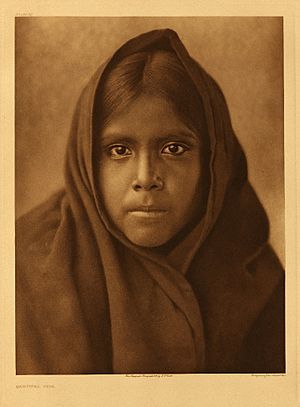Qahatika facts for kids
The Qahatika (also called Kohatk) were a group of Native American people. They lived in the desert lands of the Southwestern United States. Their home was near where the town of Quijotoa, Arizona is today.
The Qahatika Tribe
The Qahatika were closely related to the Pima tribe. They were known for their special way of farming in the desert.
Where Did They Live?
The Qahatika people lived in five small villages. These villages were deep in the desert, south of the Gila River in Arizona. They were about 40 miles away from the main Pima reservation.
Their History and Way of Life
A famous photographer and expert on Native Americans, Edward S. Curtis, studied the Qahatika. He learned that they were part of the larger Pima group.
A legend says that the Qahatika became a separate group after a big war. The Pima tribe fought against the Apache people and lost. After the defeat, the Pima tribe split up. One part of the tribe, the ancestors of the Qahatika, moved into the dry desert. They settled there, living apart from the other Pima groups.
Even in the desert, the Qahatika found ways to grow food. They were very good at "dry farming." This special farming method used only the rain that fell in winter. The soil near their villages could hold this winter moisture for a long time. Just a few winter rains were enough to help them grow a good crop of wheat in the summer.
What Were They Like?
Edward S. Curtis noted that the Qahatika looked very much like the Pima and Papago people. They kept many of the Pima traditions.
The Qahatika were skilled artists. They continued the Pima art of basket weaving. They also created their own unique style of pottery. Their homes were built using materials found in the desert. They mainly used the dried parts of giant cactus plants to build their houses.


